The Tampa Bay Rays pitching lab has done it again. Their brain trust continues to resurrect left-for-dead hurlers dumped onto the trading block by their former organizations. Whether it’s turning Tyler Glasnow into the frontline ace he was meant to be or repurposing a bunch of minor league invitees into their vaunted stable of relievers, the Rays have the secret sauce for unlocking potential. Jeffrey Springs is yet another exhibit of a reclamation project blossoming into an excellent arm. After scuffling early in his career as a reliever for the Rangers and Red Sox, Springs found new life in 2021, posting a 35% K-rate out of the bullpen to the tune of a 3.43 ERA. He followed that up in 2022 with a sparkling debut season as a starter, posting a 2.46 ERA and 1.07 WHIP in 25 starts, numbers largely backed up by his advanced metrics. Still, it’s always worth a closer look when these late-career breakouts appear out of nowhere. After all, Springs is a former 30th-round draft pick finding success at 29 years old, so skepticism is warranted. Let’s explore how Springs reinvented himself through mastery of a single pitch and whether we can expect more of the same going forward.
The Right Stuff
Springs has a three-pitch arsenal consisting of a four-seam fastball, changeup, and slider. In his minor league career, he had prodigious strikeout numbers, fanning 390 batters in 288 innings. But a lot of that was accomplished on the back of an uninspiring fastball. Heater-heavy approaches that get good results in the minors don’t necessarily translate to the majors and Springs was a good example of that. In his first three major league seasons, here are the results on his fastball along with his overall stats.
Considering the heater sits in the low-90s and Springs had command issues early in his career, these results were not surprising. Leaning into his offspeed and breaker always seemed to be the way to go. Naturally, Springs has slowly ramped down the fastball usage and increased his changeup/slider usage with each passing year. Last season, he took his changeup usage to a career-high level, tossing it about 35% of the time.
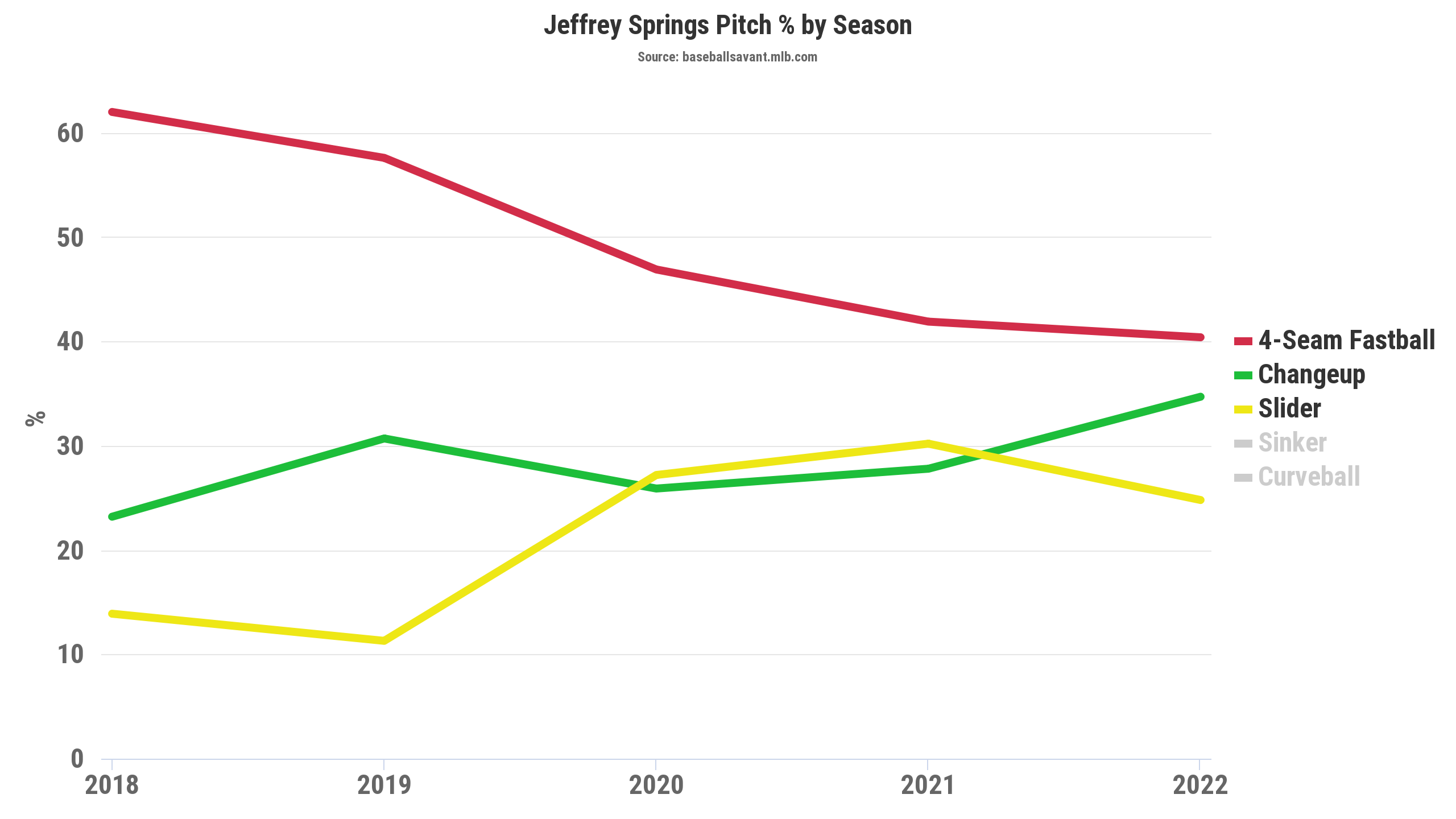
It’s amazing how much better a pitcher can be when they just throw their best pitch more. While it seems simplistic to say featuring your best pitch leads to better results, the domino effect on the rest of the arsenal is real. If you look at Springs’ Pitch Quality chart from 2022, he is truly a changed man. This is exquisite stuff.

First of all, Springs’ fastball is not even that bad. It’s certainly his worst pitch, but PLV graded all his pitches as comfortably above average. The slider returned good, but not great results. Springs’ claim to fame is the elite changeup. Its 5.60 grade ranked in the 95th percentile, only slightly behind known Airbender Devin Williams (5.71) and ahead of fellow Rays ace Shane McClanahan (5.45) and reigning Cy Young winner Sandy Alcantara (5.35). That changeup was so dominant, it allowed Springs to finish with the eighth highest PLV in the entire league! Even more incredible is the fact that the changeup’s hit luck (actual hits – expected hits) was +5, meaning the pitch was even better than it showed. This speaks volumes to the effectiveness of Springs’ arsenal headlined by that changeup. He is not doing this with smoke and mirrors – the stuff is legit.
Change(Up) For the Better
What makes Springs’ changeup so effective? He has always had a great one, but the pitch soared to new heights in 2022 thanks to an offseason grip change that added about 6-7 inches of added drop. Essentially, he was able to increase the “late” action of his changeup by getting more gyroscopic spin on the ball. Gyro spin refers to spin that does not contribute to the movement or break of the ball, much like the spiral on a football pass. Greater gyro spin means the pitch is more susceptible to gravity, thus creating that late drop. Here is his pitch movement profile in 2021 compared to 2022. (Disregard the color change as the classification system considered his fastball to be a sinker last year.)
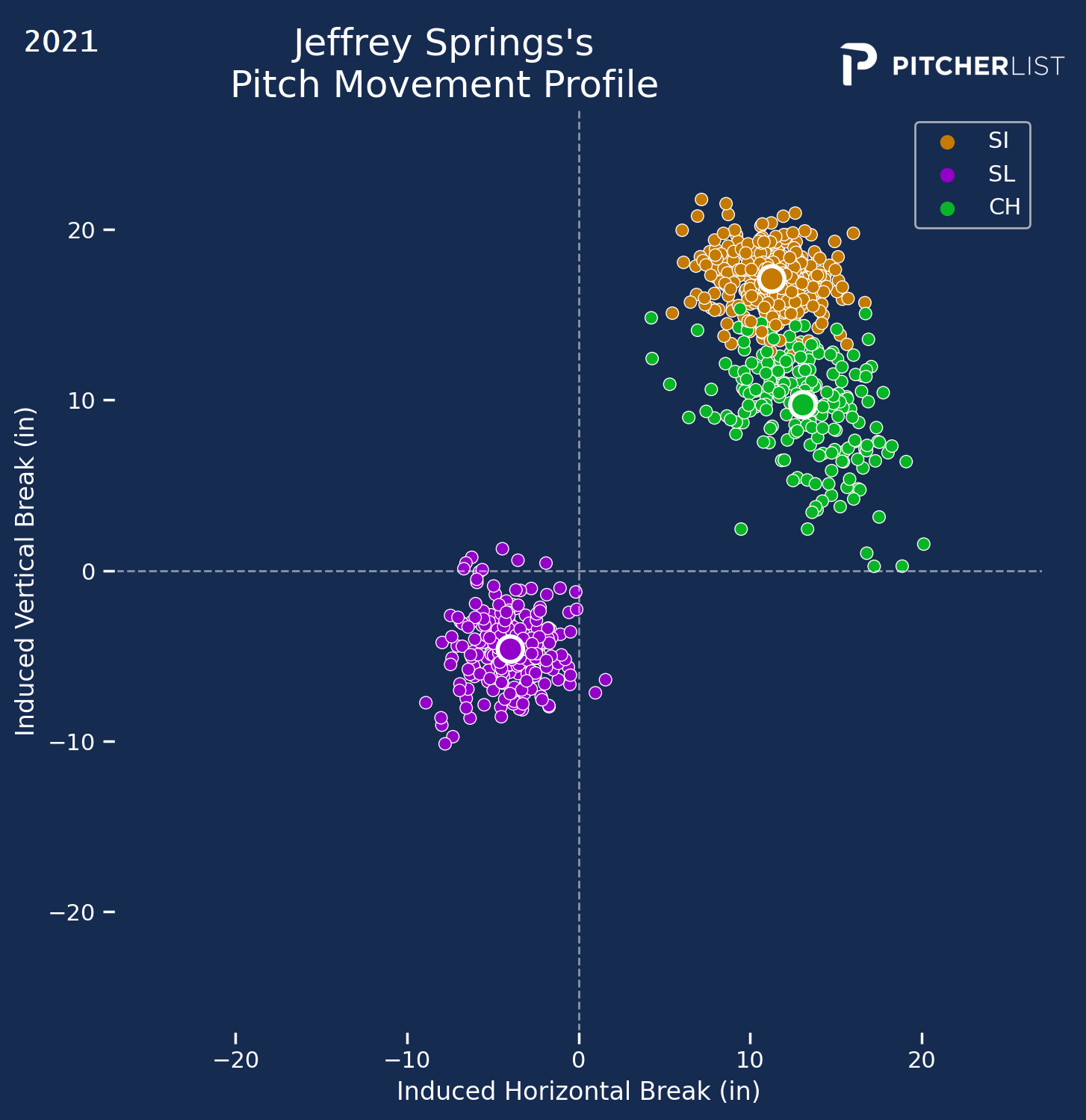
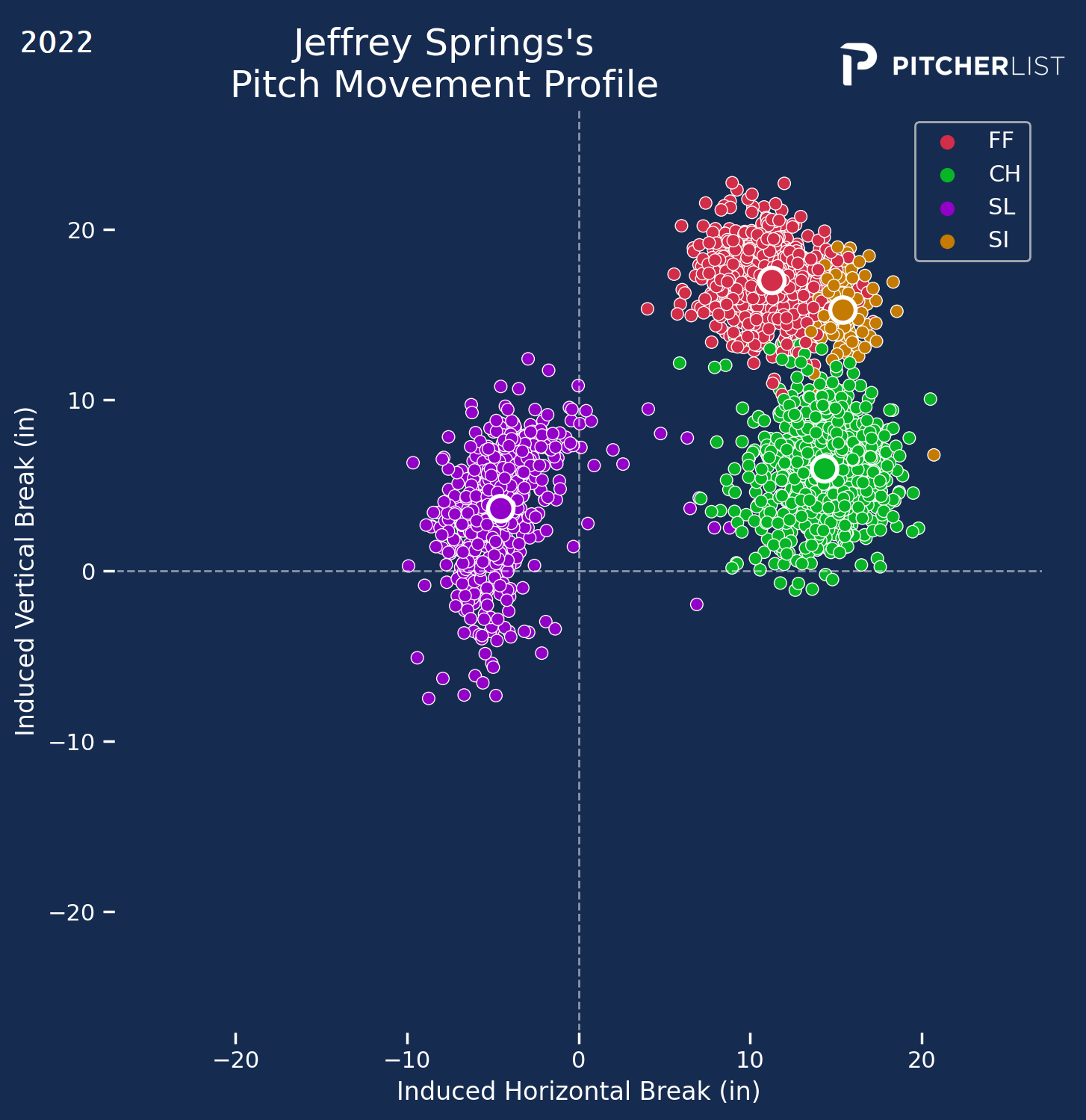
If you look at the distance between the center dot of the fastball cluster (orange on left, red on right) and the changeup cluster (green), you’ll notice a greater differential in vertical movement between the two pitches. The fastball maintained its vertical break from 2021 to 2022, but the changeup decreased in vertical break. Vertical break measures the “ride” or “carry” that gives the impression of the ball rising, caused by backspin, as it approaches the plate. On the other hand, changeups with lower spin efficiency and greater gyro spin are less gravity-resistant and therefore have less vertical break. Springs’ offseason adjustments altered the shape of his changeup from primarily fading, horizontal action to a tumbling, straight-down action. Not only did his swinging strike rates and chase rates leap up, but his fastball returned even better results.
Let’s dive into some tape to see if we can see the difference between the two pitches. Here’s a changeup to Matt Chapman early in the 2021 season.
On a 3-2 count, this is not a bad pitch by any stretch. Notice the changeup hums in at 85 mph in a decent location, a couple of balls off the plate. But as the pitch approaches the catcher’s glove, it flattens out with very little vertical movement. This allows Chapman to stick his bat head out defensively and poke it for an infield single. Now let’s fast forward a season and a half later to watch the same matchup.
Times have changed! Chapman is wearing Royal Blue instead of Kelly Green and Springs is now a starter with a new-looking changeup. This one comes in a few ticks lower, at 81 mph, but with a much sharper downward break. While the pitch location is more over the plate than the one above, the pitch shape looks vastly different. This time, Chapman sees the bottom fall right out from under him and he bends the knee.
The difference between the old and new changeup is not as noticeable in every at-bat. But all the metrics on the changeup indicate that this new version is far more devastating. Offseason reports from last year suggest Springs utilized pitching’s newest revolution of seam-shifted wake to create further pitch separation. For those interested in the science, check out Nate Schwartz’s excellent sweeper article about how SSW and understanding of the Magnus Effect are transforming the pitching landscape. It certainly has transformed Springs’ arsenal.
Now You See It, Now You Don’t
Of all the rosy stats for Springs, the most outstanding one was his 35.4% chase rate. He had hitters off-balance and guessing all season. Noticeably, Springs had reverse splits on the year, as righties couldn’t figure out how to solve his fastball-change combination. A good illustration here is his changeup strike zone plot, which shows him wearing out the bottom corner of the zone like it’s going out of style.
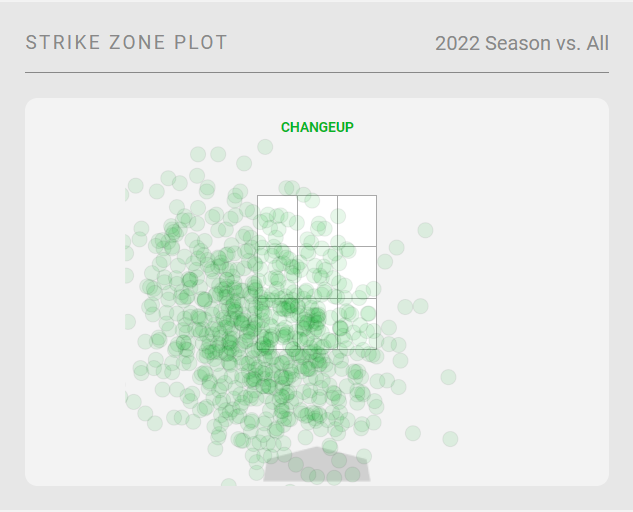
The darkest areas are off the plate and that’s by design, as the changeup returned a whopping 49.9% O-Swing percentage. Hitters swung at changeups out of the zone nearly half the time. That was the best mark in the league among qualified starting pitchers in 2022. As the saying goes, “fool me once, shame on you; fool me twice, why is your changeup so nasty?”
Remember that whole conversation about spin? Springs maximizes his stuff through identical spin patterns between the changeup and fastball out of his delivery. For pitchers with less velocity, deception makes stuff play up. The way the changeup and fastball look out of the hand is virtually the same in terms of spin direction, but the observed spin by the time the pitch reaches the plate is different.
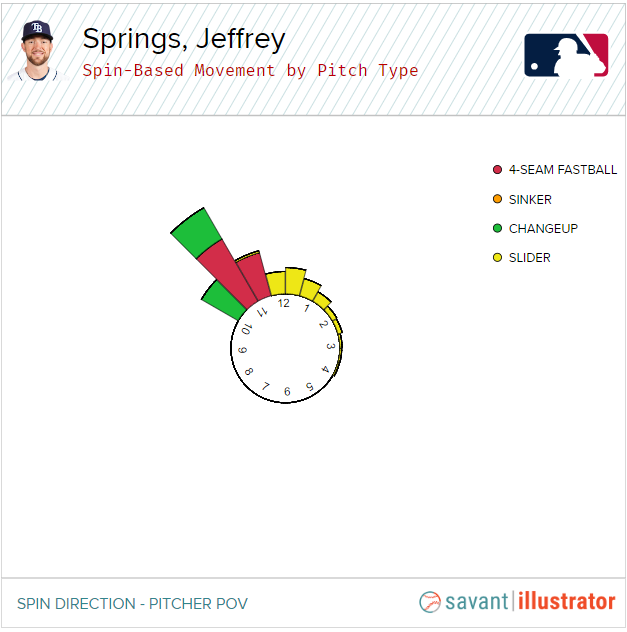
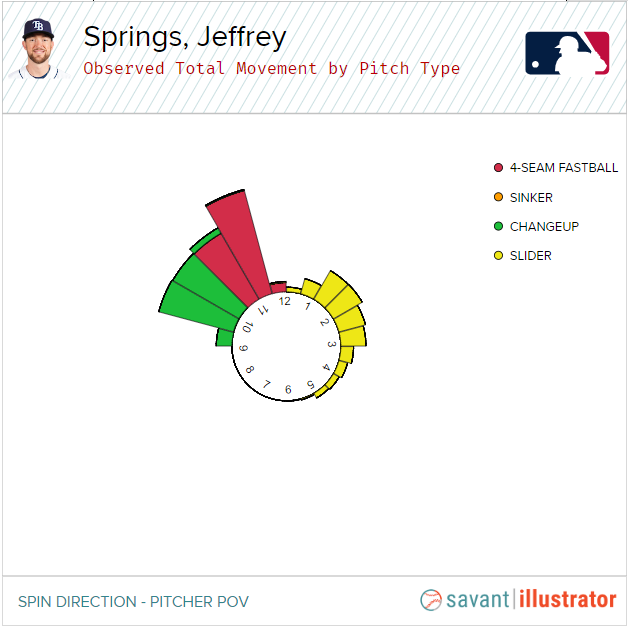
Using Statcast’s clock terminology to describe spin axis, the fastball is spinning at about 10:45 and the changeup at 10:15 upon release. By the time it reaches the plate, the changeup has now deviated to 9:45 while the fastball stays at 10:45. This extra 00:30 of deviation only showed up last season, showing why the added gyro spin has such a big effect on late movement. Springs hides the ball well and throws his two main pitches with identical spin patterns that don’t diverge until hitters have already decided to swing, which is textbook tunneling. Let’s look at some tape to see this in action.
Here is a perfect illustration of the fastball-changeup one-two punch, particularly against righties. In this matchup against Jays slugger Vladimir Guerrero Jr., Springs paints the bottom of the zone on a 2-1 count with a fastball. With count leverage, it seems odd that Guerrero Jr. would just take this pitch. But he’s clearly not sitting on the fastball and that demonstrates how the prospect of the changeup is already ingrained into hitters’ minds. So with the count back level at 2-2, let’s see what Springs does.
Same spot, same arm action, must be the same pitch, right? Nope, Springs pulls the string and absolutely flummoxes Guerrero Jr. with a tumbling changeup. If you overlaid these two videos on top of each other, everything would look identical up until the result. Springs got so many whiffs using this exact sequence, dotting the fastball and then following it up with a changeup in the same location. It’s formulaic, but it works so well because of the deception.
Encore, Please
Jeffrey Springs has arrived and is here to stay. After a spotless Spring Training performance, he followed it up with a dazzling season debut of six no-hit innings with 12 punchouts against the Tigers. Coming into 2023, he’s also added a sweeper to pair with his gyro slider, a combination that Marquee Sports’ Lance Brozdowski has analyzed with a great video breakdown. The fantasy community seems cautiously optimistic. His average valuation in drafts as SP47 with an ADP of around 160 could turn out to be an absolute bargain. From a skills perspective, he is highly capable of providing quality innings with fantastic ratios and solid strikeout numbers. The most pressing question is how much the Rays will push him in terms of pitching deep into games. His career season high of 135 innings pitched was set last year, so the only real caveat to his profile is volume. But the stuff is legitimate and the approach is very sound. The Rays rotation looks to be among the league’s best this year and Springs will be an integral part of it. He may very well take fantasy teams to the championship along the way.

